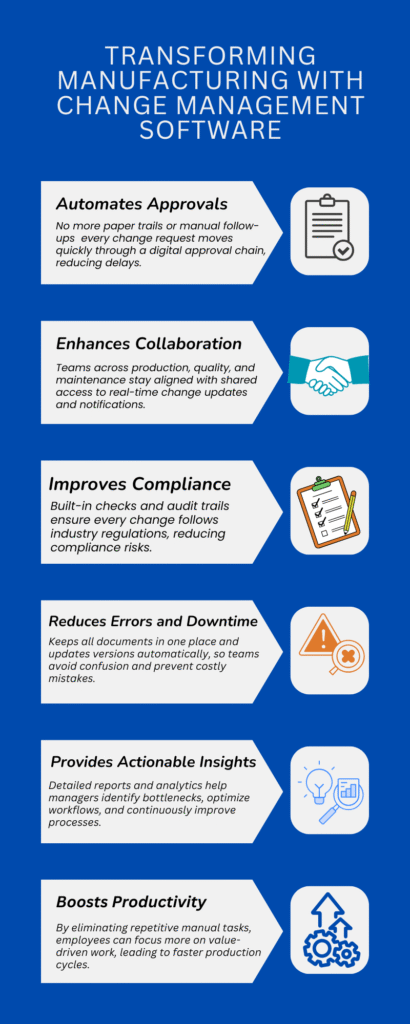Transforming Manufacturing with Digital Change Management :
Introduction:
Change Management Software is essential for all manufacturing industries. Whether it’s updating a process or replacing a machine, every change carries potential risks. Effective change management ensures that all changes are properly reviewed, approved, and implemented safely.
Step by Step Guide to Managing Change Safely in Manufacturing Processes:
1. Spotting the Change
The first step is simply noticing when a change is happening. It might sound easy, but sometimes small adjustments can have a big impact on safety. Recognizing these changes early is the key to managing them properly.
2. Assessing the Risks
Once a change is identified, it’s important to carry out a proper Risk Assessment. This means looking at how the change could affect safety, processes, or existing controls. By evaluating these risks ahead of time, potential problems can be prevented before they happen.
3. Getting Approval
No change should be made without the right approvals. This step ensures experts and managers review the change. Having extra eyes on the plan helps catch issues that may have been missed, adding another layer of safety.
4.Implementing the Change
After approval, it’s time to make the change. But it should be done carefully, following all safety steps. The goal is to put the change in place without introducing new risks.
5. Informing and Training People
A change is only safe if everyone knows about it. That’s why good communication is important. Workers need to be told what’s changing, and sometimes they need training too. Clear instructions reduce confusion and prevent accidents.
6. Watching and Reviewing
The job doesn’t stop after the change is made. It’s important to keep an eye on things to make sure no new issues show up. After some time, the change should be reviewed again to see if improvements are needed. This keeps safety strong in the long run.

Who Should Check the Change Management Process:
Managing change is not the job of one person or one department. For it to work safely, different teams must review and play their part. Each team looks at the change from their own angle, so nothing is missed.
Operations Team
This team knows the day to day work best. They check if the change will affect how machines, equipment, or processes are run. Their input helps make sure the change won’t disrupt production.
Safety Team
The safety experts focus on hazards. They check whether the change could bring new risks and if existing safety controls are enough. Their job is to ensure the change meets all safety standards.
Maintenance Team
Maintenance staff check if the change will impact equipment reliability. They look at things like repair needs, spare parts, and future servicing, so the change doesn’t cause unexpected breakdowns.
Technical Team
Engineers check the technical side of the change design, capacity, and compatibility. They make sure the change won’t overload systems or cause failures.
Final Approval Plant Manager
The Plant Manager gives the final approval. This step is critical because the Plant Manager has full responsibility for the entire site. They look at the bigger picture operations, safety, costs, and people before giving the green light. Their approval means the change has been reviewed by all teams and is safe to move forward.
Advantages of Change Management for Manufacturing Industry:
Improved Safety:
All changes go through a proper approval process before being implemented. This ensures hazards are identified and controlled at the right time. As a result workplace risks and accidents are greatly reduced.
Saving Time:
Digital workflows make approvals and communication much faster.Automated reminders replace manual paperwork and follow ups. This helps companies respond to changes quickly without unnecessary delays.
Cost Savings:
Unexpected breakdowns and downtime can be very expensive. By planning for technical and maintenance needs in advance, incident are avoided. This reduces repair costs, spare parts expenses, and lost production time.
Better Workplace Cooperation:
Change Management Software brings all information into one place. Different teams can track updates and share feedback in real time. This improves coordination and ensures everyone works together smoothly
The Role of Digital Change Management:
Digital Change Management tools make handling changes faster, easier, and more reliable.
1.Keeps records in one place : All approvals, documents, and updates are stored digitally, making it easy to track every change.
2.Improves communication across teams :Teams can share updates and feedback in real time, reducing misunderstandings.
3.Prevents delays and confusion : Automated workflows ensure tasks move smoothly without waiting on manual approvals.
4.Ensures compliance with industry standards : Digital tracking helps companies follow safety rules and regulations consistently.
Conclusion:
Change Management Software makes it easier for manufacturing companies to handle changes without confusion or delays. By keeping everything digital, teams can work together better, avoid mistakes, and stay compliant with industry rules. In the end, it helps companies save time, cut costs, and run their processes more smoothly.



